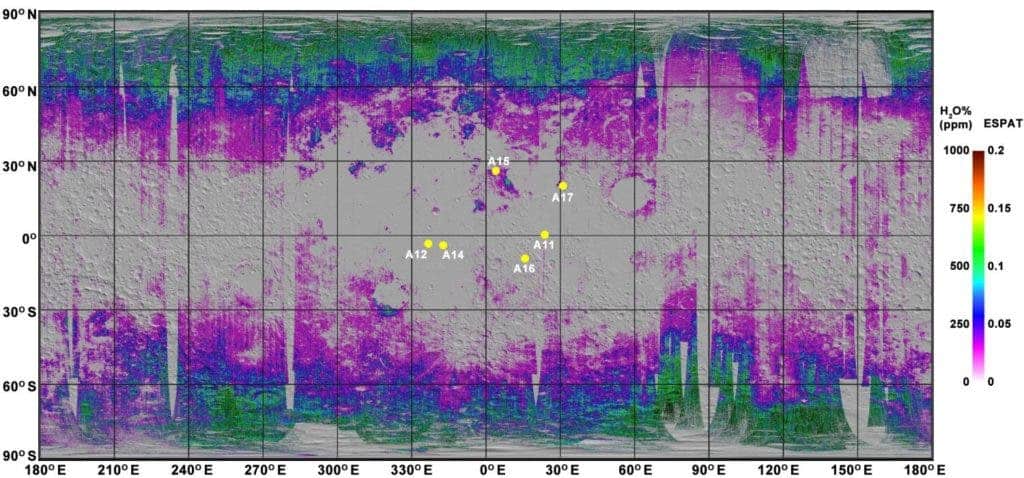Brown University geologists just released the first ever quantitative map of water trapped in the moon’s outermost layers, and it’s pretty impressive.
It was only in 2009, less than a decade ago, that scientists found the first evidence of water and hydroxyl (an important H2O building block) in the lunar soil. Strikingly, we now have a very detailed outlook of how much water is present on the moon almost at the global level.

Water content in the moon’s soil rises towards the poles and drops towards the equator. This suggests solar winds helped implant the water. The yellow dots are Apollo-era landing sites. Credit: Milliken lab / Brown University.
This latest map used re-calibrated data collected by NASA’s Moon Mineralogy Mapper, which flew aboard India’s Chandrayaan-1 spacecraft. Not too long ago, scientists used to believe the bulk of moon’s water was trapped in its polar regions. As this new map shows, however, the signature of water is present almost everywhere on the moon’s surface.
Dry or wet moon? The jury is still out
It’s not that much water to begin with, though. Before anyone gets too excited, it’s worth considering that the maximum average concentration identified thus far is 500 to 750 parts per million. That’s even less than you can find in the sand of the driest deserts on Earth. Yet, something is still more than nothing. What’s more, there may be much more water than currently measured, seeing how the Moon Mineralogy Mapper can only sense “the upper millimeter or so of soil,” according to the researchers.
“This is a roadmap to where water exists on the surface of the Moon,” said Ralph Milliken, an associate professor at Brown, in a statement. “Now that we have these quantitative maps showing where the water is and in what amounts, we can start thinking about whether or not it could be worthwhile to extract, either as drinking water for astronauts or to produce fuel.”
While water can be found virtually everywhere in the moon’s uppermost layers, the concentration rises at higher latitudes and drops close to the equator. This offers some clues as to how all that water was sourced. For instance, the distribution pattern is consistent with solar wind implantation. This hypothesis suggests proton bombardment can trigger the formation of hydroxyl and molecular water once emplaced.
In other places, like around lunar the volcanic deposits near the moon’s equator, water deposits likely comes from lunar magma that erupted from deep within the satellite’s mantle.
One of the most interesting findings is that water content fluctuates over the course of the lunar day at latitudes lower than 60 degrees. Some regions’ water concentration oscillates by as much as 200 parts per million, going from wetter in the early morning and evening to nearly bone dry around lunar noon.
Another recent study published by scientists at TU Dortmund University, Germany, lists “hydrated minerals or a reservoir at large depth” as other possible sources for the lunar water. “This would imply the presence of significant amounts of water in the lunar interior,” said Christian TU Dortmund.
“We don’t know exactly what the mechanism is for this fluctuation, but it tells us that the process of water formation in the lunar soil is active and happening today,” Milliken said. “This raises the possibility that water may re-accumulate after extraction, but we need to better understand the physics of why and how this happens to understand the timescale over which water may be renewed.”
The map is missing some key information, though. The Moon Mineralogy Mapper measures light reflected off of the lunar surface to collect information about water content. Seeing how some regions of the moon are permanently shadowed from the sun’s rays, there’s no way to measure water concentration with this method. Researchers have some hunches that these regions trap large deposits of ice, especially in the floors of impact craters that scatter the moon’s polar regions.
Even so, while incomplete, this map provides an excellent starting point for others to build over. It’s exciting to imagine the prospect of mining water — and likely other resources — from the moon’s soil for a potential human lunar colony.
“It remains to be seen whether extraction could be feasible,” Milliken said. “But these results show us what the range of water availability across the surface is so we can start thinking about where we might want to go to get it and whether it makes economic sense to do so.”
Scientific reference: “Water on the surface of the Moon as seen by the Moon Mineralogy Mapper: Distribution, abundance, and origins” Science Advances (2017). advances.sciencemag.org/content/3/9/e1701471 .









